Perceived and Reported Reliability of the Electricity Supply at Three Urban Locations in Indonesia
Abstract
:1. Introduction
2. Literature Review
2.1. Energy Demand and Electricity Supply in Indonesia
2.2. Reliability of Electric Power
2.3. User Perception to Evaluate Reliability of Electricity Supply
3. Research Questions and Methods
3.1. Research Questions
- What is the officially-reported reliability of the power supply in Indonesia?This is answered through a desk study by analysis of PLN’s annual reports containing SAIDI and SAIFI values for each province in Indonesia. The results of the analysis are presented in Section 4.1.
- How do users in urban areas of Indonesia experience their power supply in practice?This question aims to discover the actual experiences of PLN customers in urban areas regarding the reliability of the electricity supply. To answer this question, a user study on households’ experiences was executed in three locations in Indonesia, including the cities of Pekanbaru in the Province of Riau, Kupang in the Province of ENT, and Jayapura in the Province of Papua. The results are reviewed in Section 4.2.
- What is the actual power quality in distribution grids in Indonesia?This question is for providing evidence on the existence of outages and voltage fluctuation at the three study locations by conducting short-term measurements of power quality of the PLN distribution networks. The results are outlined in Section 4.3.
3.2. Methods
3.2.1. Desk Study
3.2.2. Experimental Set up of Field Research
End-User Survey
- Would you accept an increase in your electricity bill for better electricity service?
- How much increase in your electricity bill would you find acceptable?
- Do you have a backup generator at home?
- Do you experience a stable electricity voltage at home? (in this paper, the “stable electricity voltage” is used as a general phrase in the questionnaires, which refers to a minimum level of voltage fluctuation. See also Section 4.2.1.)
- Have you ever experienced a blackout at home?
- On average, how often in a month do you experience blackouts?
- On average, how long is the duration of the blackouts you experience?
- At what time of day would a blackout event incur the most losses for you?
- On average, what is the duration of a blackout that would incur economic losses for you?
Power Quality Measurements
4. Results
4.1. SAIDI and SAIFI
4.2. Household Experiences
4.2.1. The Perceived Importance of Reliable Electricity Supply and Stable Voltage
4.2.2. Blackout Events
4.2.3. P-SAIFI and P-SAIDI
4.3. Results from Measurements at the Distribution Grid
5. Discussion and Conclusions
5.1. Desk Study, User Study, and Grid Measurements
5.2. Methods
5.3. Limitations of the Study
- 1)
- While the values for SAIDI and SAIFI are provincial values, our study occurred at specific locations, namely in the capital cities of the three provinces. However, it is still surprising that the officially reported values of reliability indices are lower than those recorded by measurements on the grid and reported by end-users. In fact, higher values can be expected for the officially reported SAIDI and SAIFI because they cover the whole province, which contains urban areas, with a relatively high-quality supply of electricity, and rural areas, which tend to have a lower power quality. It would, therefore, be valuable to expand this study to other locations in these provinces and other provinces to produce more evidence. This study offers a good start, which might be continued by other researchers.
- 2)
- The 26 respondents in Jayapura are not a representative sample for this study. Therefore, given the importance of the opinions from the end-users regarding the reliability of the electricity supply, the quantity of respondents in a future follow-up study should be increased to improve the statistics. Then, the statistic of respondents could also be more equally distributed over the three locations, levels of income, and other demographic variables to minimize any bias. Similarly, the duration of the measurements of the electricity grid could be increased.
- 3)
- In our study, an income-bias of the respondents was not accounted for. As a result, this study mostly represents high and upper-middle income classes.
Acknowledgments
Author Contributions
Conflicts of Interest
Appendix A
| No. of Respondents | Pekanbaru | Kupang | Jayapura |
| 114 | 65 | 26 | |
| The Distribution of Respondents by City Address (%) | |||
| - Urban-core | 53 | 45 | 23 |
| - Sub-Urban | 47 | 55 | 77 |
| Monthly Income (%) | |||
| - High | 28 | 5 | 4 |
| - Upper-Middle | 43 | 28 | 50 |
| - Lower-Middle | 17 | 49 | 27 |
| - Low | 6 | 15 | 0 |
| - Not answer | 6 | 3 | 19 |
| Sex (%) | |||
| - Male | 49 | 51 | 42 |
| - Female | 51 | 49 | 58 |
| Age Groups (%) | |||
| - 18–29 | 11 | 5 | 31 |
| - 30–49 | 63 | 54 | 58 |
| - 50–64 | 23 | 35 | 12 |
| - 65+ | 4 | 6 | 0 |
| Education (%) | |||
| - No school | 0 | 2 | 0 |
| - Basic school | 8 | 14 | 0 |
| - High school | 50 | 42 | 0 |
| - Undergraduate | 30 | 38 | 8 |
| - Postgraduate | 5 | 3 | 85 |
| - No answer | 7 | 2 | 8 |
Appendix B
- Would you accept an increase in your electricity bill for better electricity service?
- Yes
- No
- How much increase in your electricity bill would you find acceptable?
- 10%–30%
- 30%–50%
- 50%–70%
- Do you have a backup generator at home?
- Yes
- No
- Do you experience a stable electricity voltage at home?
- Yes
- No
- Have you ever experienced a blackout at home?
- Yes
- No
- On average, how often in a month do you experience blackouts?
- less than 3 x
- 3–5 x
- 6–10 x
- more than 10 x
- On average, how long is the duration of the blackouts you experience?
- <5 min
- 5–15 min
- 15–60 min
- >120 min
- At what time of day would a blackout event incur the most losses for you?
- 6 a.m.–12 a.m.
- 12 a.m.–6 p.m.
- 6 p.m.–12 p.m.
- 12 p.m.–6 a.m.
- On average, what is the duration of a blackout that would incur economic losses for you?
- less than 5 min
- 5–15 min
- 15–60 min
- more than 120 min
Appendix C
| Question 1 | Would you accept an increase in your electricity bill for better electricity service? | |||||||||||||||||
| Answer | Yes | No | NA | |||||||||||||||
| P | K | J | P | K | J | P | K | J | ||||||||||
| 56 | 68 | 58 | 35 | 31 | 38 | 9 | 2 | 4 | ||||||||||
| Question 2 | How much increase in your electricity bill would you find acceptable? | |||||||||||||||||
| Answer | 10%–30% | 30%–50% | 50%–70% | NA | ||||||||||||||
| P | K | J | P | K | J | P | K | J | P | K | J | |||||||
| 89 | 55 | 50 | 7 | 0 | 0 | 0 | 0 | 0 | 4 | 45 | 50 | |||||||
| Question 3 | Do you have a backup generator at home? | |||||||||||||||||
| Answer | Yes | No | NA | |||||||||||||||
| P | K | J | P | K | J | P | K | J | ||||||||||
| 21 | 14 | 65 | 67 | 83 | 27 | 12 | 3 | 8 | ||||||||||
| Question 4 | Do you experience a stable electricity voltage at home? | |||||||||||||||||
| Answer | Yes | No | NA | |||||||||||||||
| P | K | J | P | K | J | P | K | J | ||||||||||
| 82 | 49 | 50 | 11 | 48 | 42 | 8 | 3 | 8 | ||||||||||
| Question 5 | Have you ever experienced a blackout at home? | |||||||||||||||||
| Answer | Yes | No | NA | |||||||||||||||
| P | K | J | P | K | J | P | K | J | ||||||||||
| 89 | 97 | 85 | 2 | 0 | 8 | 10 | 3 | 8 | ||||||||||
| Question 6 | On average, how often in a month do you experience blackouts? | |||||||||||||||||
| Answer | <3 x | 3–5 x | 6–10 | >10 x | NA | |||||||||||||
| P | K | J | P | K | J | P | K | J | P | K | J | P | K | J | ||||
| 37 | 37 | 8 | 39 | 25 | 46 | 10 | 31 | 35 | 10 | 5 | 4 | 4 | 3 | 8 | ||||
| Question 7 | On average, how long (in minutes) is the duration of the blackouts you experience? | |||||||||||||||||
| Answer | <5 | 5–15 | 15–60 | 60–120 | >120 | NA | ||||||||||||
| P | K | J | P | K | J | P | K | J | P | K | J | P | K | J | P | K | J | |
| 0 | 0 | 0 | 3 | 5 | 12 | 19 | 12 | 15 | 60 | 66 | 54 | 14 | 12 | 12 | 4 | 5 | 8 | |
| Question 8 | At what time of day would a blackout event incur the most losses for you? | |||||||||||||||||
| Answer | 6 a.m.–12 a.m. | 12 a.m.–6 p.m. | 6 p.m.–12 p.m. | 12 p.m.–6 a.m. | NA | |||||||||||||
| P | K | J | P | K | J | P | K | J | P | K | J | P | K | J | ||||
| 27 | 52 | 58 | 13 | 8 | 4 | 52 | 29 | 23 | 2 | 0 | 0 | 6 | 11 | 15 | ||||
| Question 9 | On average, what is the duration (in minutes) of a blackout that would incur economic losses for you? | |||||||||||||||||
| Answer | <5 | 5–15 | 15–60 | 60–120 | >120 | NA | ||||||||||||
| P | K | J | P | K | J | P | K | J | P | K | J | P | K | J | P | K | J | |
| 3 | 2 | 0 | 2 | 2 | 8 | 6 | 12 | 15 | 72 | 72 | 54 | 4 | 6 | 12 | 13 | 6 | 12 | |
References
- International Energy Agency. World Energy Outlook 2016 Executive Summary; International Energy Agency: Paris, France, 2016. [Google Scholar]
- Perusahaan Listrik Negara (PLN). Statistik PLN 2015; PLN: Jakarta, Indonesia, 2016. [Google Scholar]
- Khoury, J.; Mbayed, R.; Salloum, E.; Monmasson, E. Optimal sizing of a residential PV-battery backup for an intermittent primary energy source under realistic constraints. Energy Build. 2015, 105, 206–216. [Google Scholar] [CrossRef]
- Alramlawi, M.; Gabash, A.; Li, P. Optimal operation strategy of a hybrid PV-battery system under grid scheduled blackouts. In Proceedings of the IEEE International Conference on Environment and Electrical Engineering and 2017 IEEE Industrial and Commercial Power Systems Europe (EEEIC/I&CPS Europe), Milan, Italy, 6–9 June 2017. [Google Scholar]
- Hasan, M.H.; Mahlia, T.M.I.; Nur, H. A review on energy scenario and sustainable energy in Indonesia. Renew. Sustain. Energy Rev. 2012, 16, 2316–2328. [Google Scholar] [CrossRef]
- Murphy, P.M.; Twaha, S.; Murphy, I.S. Analysis of the cost of reliable electricity: A new method for analyzing grid connected solar, diesel and hybrid distributed electricity systems considering an unreliable electric grid, with examples in Uganda. Energy 2014, 66, 523–534. [Google Scholar] [CrossRef]
- World Bank. Enterprise Surveys Data for Indonesia. Available online: http://www.enterprisesurveys.org/ (accessed on 26 November 2017).
- Institute of Electrical and Electronics Engineers. IEEE Guide for Electric Power Distribution Reliability Indices; IEEE: New York, NY, USA, 2012. [Google Scholar]
- Government of Indonesia. President Decree Regarding National Energy General Plan, 2016–2050; Government of Indonesia: Jakarta, Indonesia, 2016. [Google Scholar]
- Dalet, D. Indonesia, D-Maps. Available online: http://www.d-maps.com/ (accessed on 12 July 2017).
- Asian Development Bank. Achieving Universal Electricity Access in Indonesia; Asian Development Bank: Metro Manila, Philippines, 2016; p. 113. Available online: https://www.adb.org/sites/default/files/publication/182314/achieving-electricity-access-ino.pdf (accessed on 21 July 2017).
- The World Bank. Acess to Electricity. Available online: http://data.worldbank.org/indicator/EG.ELC.ACCS.ZS (accessed on 23 July 2017).
- International Energy Agency. Electricity access in Developing Asia—2016. Available online: www.worldenergyoutlook.org/media/weowebsite/2015/WEO2016Electricity.xlsx (accessed on 23 17).
- Knoema, Quality of Electricity Supply. The World Bank. Available online: https://knoema.com/WFGCI2014/the-global-competitiveness-index-2014-2015-data-platform-2014?tsId=1074960 (accessed on 8 November 2016).
- CRO Forum. Power Blackout Risks: Risk Management Options. Available online: https://www.allianz.com/v_1339677769000/media/responsibility/documents/position_paper_power_blackout_risks.pdf (accessed on 3 November 2016).
- Erahman, Q.F.; Purwanto, W.W.; Sudibandriyo, M.; Hidayatno, A. An assessment of Indonesia’s energy security index and comparison with seventy countries. Energy 2016, 111, 364–376. [Google Scholar] [CrossRef]
- Hashim, J.H.; Hashim, Z. Climate Change, Extreme Weather Events, and Human Health Implications in the Asia Pacific Region. Asia Pac. J. Public Health 2016, 28, 8S–14S. [Google Scholar] [CrossRef] [PubMed]
- Zoro, R.; Mefiardhi, R. Insulator Damages due to Lightning Strikes in Power System: Some Experiences in Indonesia. In Proceedings of the 2006 IEEE 8th International Conference on Properties & Applications of Dielectric Materials, Bali, Indonesia, 26–30 June 2006. [Google Scholar]
- Christian, H.J.; Blakeslee, R.J.; Boccippio, D.J.; Boeck, W.L.; Buechler, D.E.; Driscoll, K.T.; Goodman, S.J.; Hall, J.M.; Koshak, W.J.; Mach, D.M.; et al. Global frequency and distribution of lightning as observed from space by the Optical Transient Detector. J. Geophys. Res. Atmos. 2003, 108, ACL 4-1–ACL 4-15. [Google Scholar] [CrossRef]
- Bi, C.; Qi, B. Reliability improvement of long distance transmission line protection in Indonesia. In Proceedings of the 2016 China International Conference on Electricity Distribution (CICED), Xi’an, China, 10–13 August 2016. [Google Scholar]
- National Aeronautics and Space Administration (NASA). Lightning Flash Rate. Available online: https://www.nasa.gov/vision/earth/lookingatearth/intense_storms.html (accessed on 11 July 2017).
- Chattopadhyay, S.; Mitra, M.; Sengupta, S. Electric Power Quality; Springer: Dordrecht, The Netherlands, 2011. [Google Scholar]
- Pontt, J.; Rodríguez, J.; Valderrama, W.; Sepúlveda, G.; Alzamora, G. Resonance effects, power quality and reliability issues of high-power converters-fed drives employed in modern SAG circuits. Miner. Eng. 2004, 17, 1125–1134. [Google Scholar] [CrossRef]
- Sjöberg, L. Political decisions and public risk perception. Reliab. Eng. Syst. Saf. 2001, 72, 115–123. [Google Scholar] [CrossRef]
- Ozbafli, A.; Jenkins, G.P. Estimating the willingness to pay for reliable electricity supply: A choice experiment study. Energy Econ. 2016, 56, 443–452. [Google Scholar] [CrossRef]
- Jimenez, R.; Serebrisky, T.; Mercado, J. What does “better” mean? Perceptions of electricity and water services in Santo Domingo. Util. Policy 2016, 41, 15–21. [Google Scholar] [CrossRef]
- Bernués, A.; Rodríguez-Ortega, T.; Ripoll-Bosch, R.; Alfnes, F. Socio-Cultural and Economic Valuation of Ecosystem Services Provided by Mediterranean Mountain Agroecosystems. PLoS ONE 2014, 9, e102479. [Google Scholar] [CrossRef] [PubMed]
- O’Connor, B.; Balasubramanyan, R.; Routledge, B.R.; Smith, N.A. From Tweets to Polls: Linking Text Sentiment to Public Opinion Time Series. In Proceedings of the Fourth International AAAI Conference on Weblogs and Social Media, Washington, DC, USA, 23–26 May 2010. [Google Scholar]
- Matsukawa, I.; Fujii, Y. Customer Preferences for Reliable Power Supply: Using Data on Actual Choices of Back-Up Equipment. Rev. Econ. Stat. 1994, 76, 434–446. [Google Scholar] [CrossRef]
- Sagebiela, J.; Rommel, K. Preferences for electricity supply attributes in emerging megacities—Policy implications from a discrete choice experiment of private households in Hyderabad, India. Energy Sustain. Dev. 2014, 21, 89–99. [Google Scholar] [CrossRef]
- Sagebiel, J.; Müller, J.R.; Rommel, J. Are consumers willing to pay more for electricity from cooperatives? Results from an online Choice Experiment in Germany. Energy Res. Soc. Sci. 2014, 2, 90–101. [Google Scholar] [CrossRef] [Green Version]
- Kalkbrenner, B.J.; Yonezawa, K.; Roosen, J. Consumer preferences for electricity tariffs: Does proximity matter? Energy Policy 2017, 107, 413–424. [Google Scholar] [CrossRef]
- Bartczak, A.; Chilton, S.; Czajkowskia, M.; Meyerhoff, J. Gain and loss of money in a choice experiment. The impact of financial loss aversion and risk preferences on willingness to pay to avoid renewable energy externalities. Energy Econ. 2017, 65, 326–334. [Google Scholar] [CrossRef]
- Sagebiel, J. Preference heterogeneity in energy discrete choice experiments: A review on methods for model selection. Renew. Sustain. Energy Rev. 2017, 69, 804–811. [Google Scholar] [CrossRef]
- Shina, J.; Hwang, W.-S. Consumer preference and willingness to pay for a renewable fuel standard (RFS) policy: Focusing on ex-ante market analysis and segmentation. Energy Policy 2017, 106, 32–40. [Google Scholar] [CrossRef]
- Harapan, H.; Anwar, S.; Bustamam, A.; Radiansyah, A.; Angraini, P.; Fasli, R.; Salwiyadi, S.; Bastian, R.A.; Oktiviyari, A.; Akmal, I.; et al. Willingness to pay for a dengue vaccine and its associated determinants in Indonesia: A community-based, cross-sectional survey in Aceh. Acta Trop. 2017, 166, 249–256. [Google Scholar] [CrossRef] [PubMed]
- Vollmer, D.; Ryffel, A.N.; Djaja, K.; Grêt-Regamey, A. Examining demand for urban river rehabilitation in Indonesia: Insights from a spatially explicit discrete choice experiment. Land Use Policy 2016, 57, 514–525. [Google Scholar] [CrossRef]
- Suparman, Y.; Folmer, H.; Oud, J.H.L. The willingness to pay for in-house piped water in urban and rural Indonesia. Pap. Reg. Sci. 2016, 95, 407–426. [Google Scholar] [CrossRef]
- Ghozali, A.; Kaneko, S. Climate Change Policies and Challenges in Indonesia Consumer Behavior and Ecolabeling; Springer: Tokyo, Japan, 2016. [Google Scholar]
- Tan Soo, J.S. Valuing Air Quality in Indonesia Using Households’ Locational Choices. Environ. Resour. Econ. 2017, 1–22. [Google Scholar] [CrossRef]
- Anna, Z.Z.Z. Economic valuation of whale shark tourism in Cenderawasih Bay National Park, Papua, Indonesia. Biodiversitas 2017, 18, 1026–1034. [Google Scholar] [CrossRef]
- Hendratmoko, P.; Guritnaningsih, G.; Tjahjono, T. Analysis of interaction between preferences and intention for determining the behavior of vehicle maintenance pay as a basis for transportation road safety assessment. Int. J. Technol. 2016, 7, 105–113. [Google Scholar] [CrossRef]
- Ambarwati, L.; Verhaeghe, R.; Arem, B.V.; Pel, A.J. Assessment of transport performance index for urban transport development strategies—Incorporating residents’ preferences. Environ. Impact Assess. Rev. 2017, 6, 107–115. [Google Scholar] [CrossRef]
- Kojima, R.; Ishikawa, M. Consumer willingness-to-pay for packaging and contents in Asian countries. Waste Manag. 2017, 68, 724–731. [Google Scholar] [CrossRef] [PubMed]
- Miller, S.; Tait, P.; Saunders, C.; Dalziel, P.; Rutherford, P.; Abell, W. Estimation of consumer willingness-to-pay for social responsibility in fruit and vegetable products: A cross-country comparison using a choice experiment. J. Consum. Behav. 2017, 16, 13–25. [Google Scholar] [CrossRef]
- Lensink, R.; Raster, T.; Timmer, A. Liquidity Constraints and Willingness to Pay for Solar Lamps and Water Filters in Jakarta. Eur. J. Dev. Res. 2017, 1–11. [Google Scholar] [CrossRef]
- Kumashiro, H.; Kharisma, V.; Sianipar, C.P.M.; Koido, K.; Takahashi, R.; Dowaki, K. The design of an appropriate geothermal energy system. In Proceedings of the 5th International Conference on Energy and Sustainability, Putrajaya, Malaysia, 16–18 December 2014. [Google Scholar]
- Perusahaan Listrik Negara (PLN). Statistik PLN 2010; PLN: Jakarta, Indonesia, 2011. [Google Scholar]
- Perusahaan Listrik Negara (PLN). Statistik PLN 2011; PLN: Jakarta, Indonesia, 2012. [Google Scholar]
- Perusahaan Listrik Negara (PLN). Statistik PLN 2012; PLN: Jakarta, Indonesia, 2013. [Google Scholar]
- Perusahaan Listrik Negara (PLN). Statistik PLN 2013; PLN: Jakarta, Indonesia, 2014. [Google Scholar]
- Perusahaan Listrik Negara (PLN). Statistik PLN 2014; PLN: Jakarta, Indonesia, 2015. [Google Scholar]
- Matthews, B.; Ross, L. Research Methods: A Practical Guide for the Social Sciences; Pearson Longman: Harlow, UK, 2010. [Google Scholar]
- List, J.A.; Gallet, C.A. What Experimental Protocol Influence Disparities Between Actual and Hypothetical Stated Values? Environ. Resour. Econ. 2001, 20, 241–254. [Google Scholar] [CrossRef]
- Manikandan, S. Measures of central tendency: The mean. J. Pharmacol. Pharmacother. 2011, 2, 140–142. [Google Scholar] [CrossRef] [PubMed]
- Mathcentre. Variance and Standard Deviation (Grouped Data). Available online: http://www.mathcentre.ac.uk (accessed on 22 October 2017).
- Ministry of Energy and Mineral Resources. Minister of Energy and Mineral Resources Decree No. 18/2016 Regarding Sumatra Electric Power System Regulation; Ministry of Energy and Mineral Resources: Jakarta, Indonesia, 2016. [Google Scholar]
- DeCaria, J.E.; Montero-Odasso, M.; Wolfe, D.; Chesworth, B.M.; Petrella, R.J. The effect of intra-articular hyaluronic acid treatment on gait velocity in older knee osteoarthritis patients: A randomized, controlled study. Arch. Gerontol. Geriatr. 2012, 55, 310–315. [Google Scholar] [CrossRef] [PubMed]
- Štěrbová, V.; Kupka, J.; Thomas, J.; Lichnovský, J.; Andráš, P. Land snail assemblages of production forest in relation to selected environmental factors (HrabĚtice forest, Czech republic). In Proceedings of the 15th International Multidisciplinary Scientific GeoConference on Surveying Geology and Mining Ecology Management, SGEM, Albena, Bulgaria, 18–24 June 2015; Volume 2, pp. 295–299. [Google Scholar]
- Stout, W.A., Jr.; Tawney, B. An excel forecasting model to aid in decisionmaking that affects hospital resource/bed utilization-hospital capability to admit emergency room patients. In Proceedings of the 2005 IEEE Systems and Information Engineering Design Symposium, Charlottesville, VA, USA, 29 April 2005; pp. 222–228. [Google Scholar]
- Carlsson, F.; Martinsson, P. Willingness to pay among Swedish households to avoid power outages: A random parameter Tobit model approach. Energy J. 2007, 28, 75–89. [Google Scholar] [CrossRef]
- Kirubi, C.; Jacobson, A.; Kammen, D.M.; Mills, A. Community-Based Electric Micro-Grids Can Contribute to Rural Development: Evidence from Kenya. World Dev. 2009, 37, 1208–1221. [Google Scholar] [CrossRef]
- Goel, L. A Comparison of Distribution System Reliability Indices for Different Operating Configurations. Electr. Mach. Power Syst. 1999, 27, 1029–1039. [Google Scholar] [CrossRef]
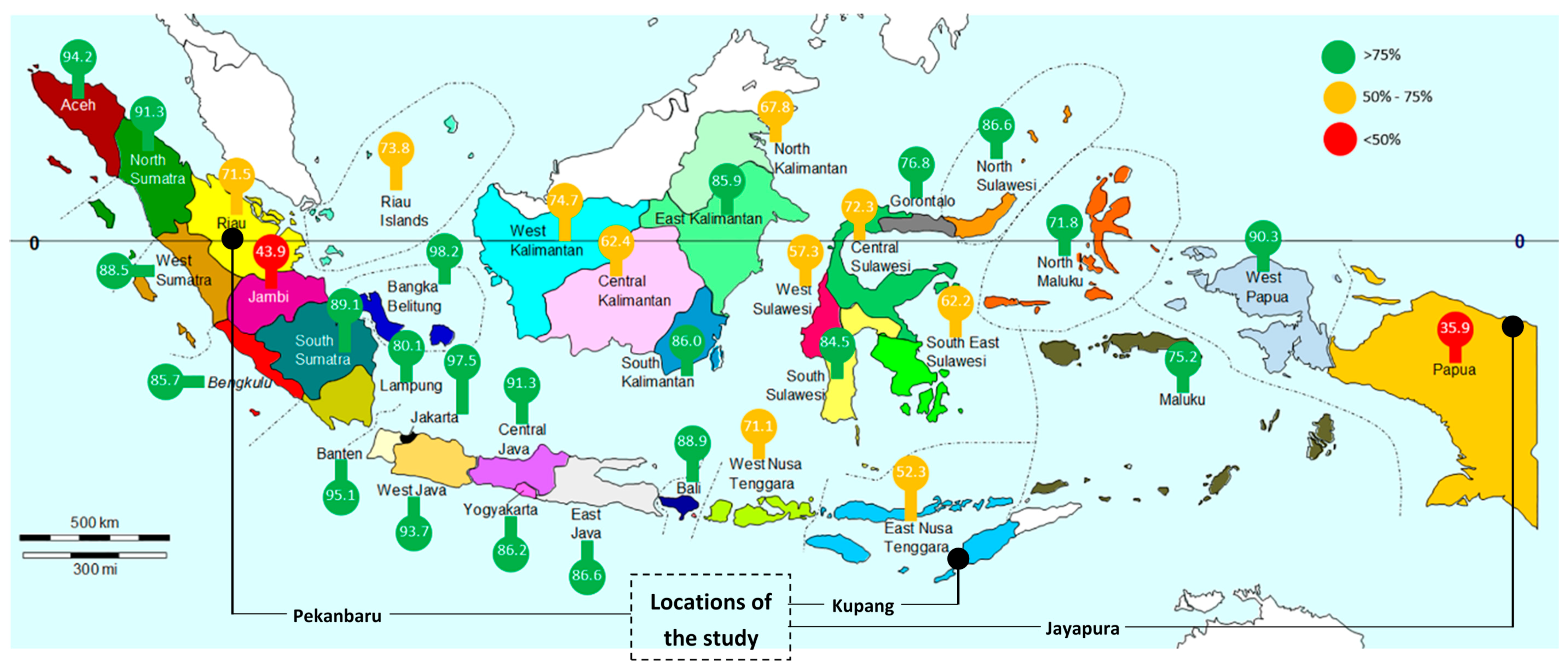
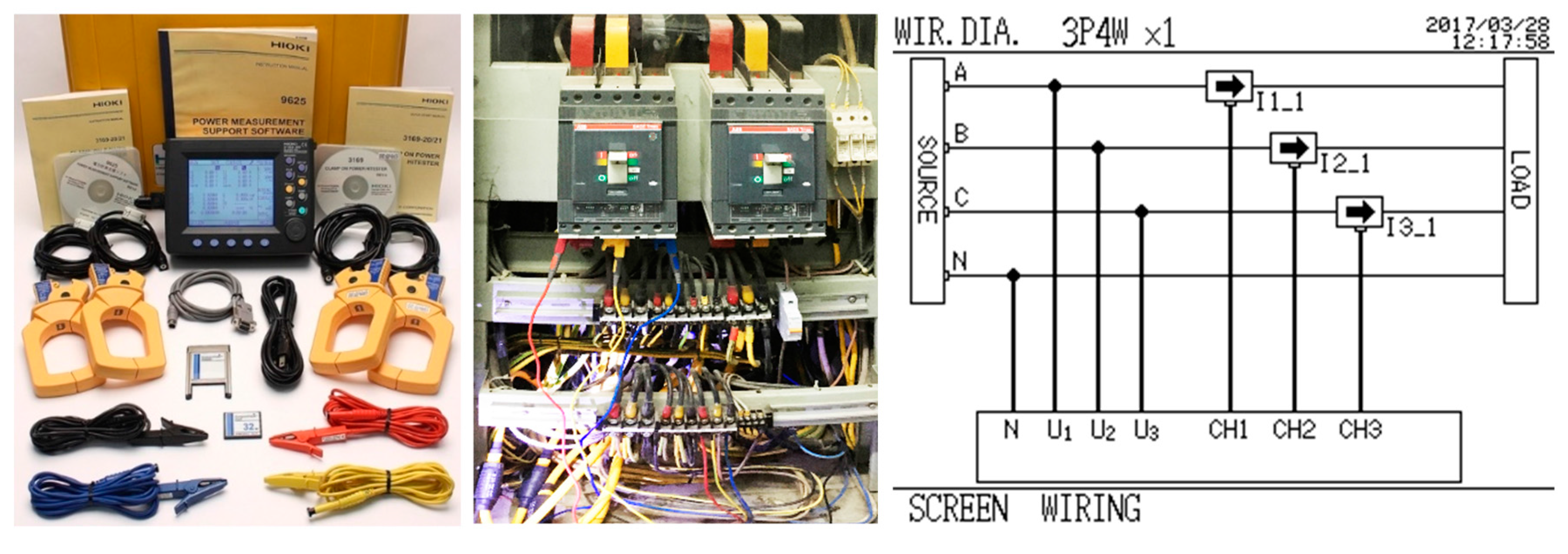
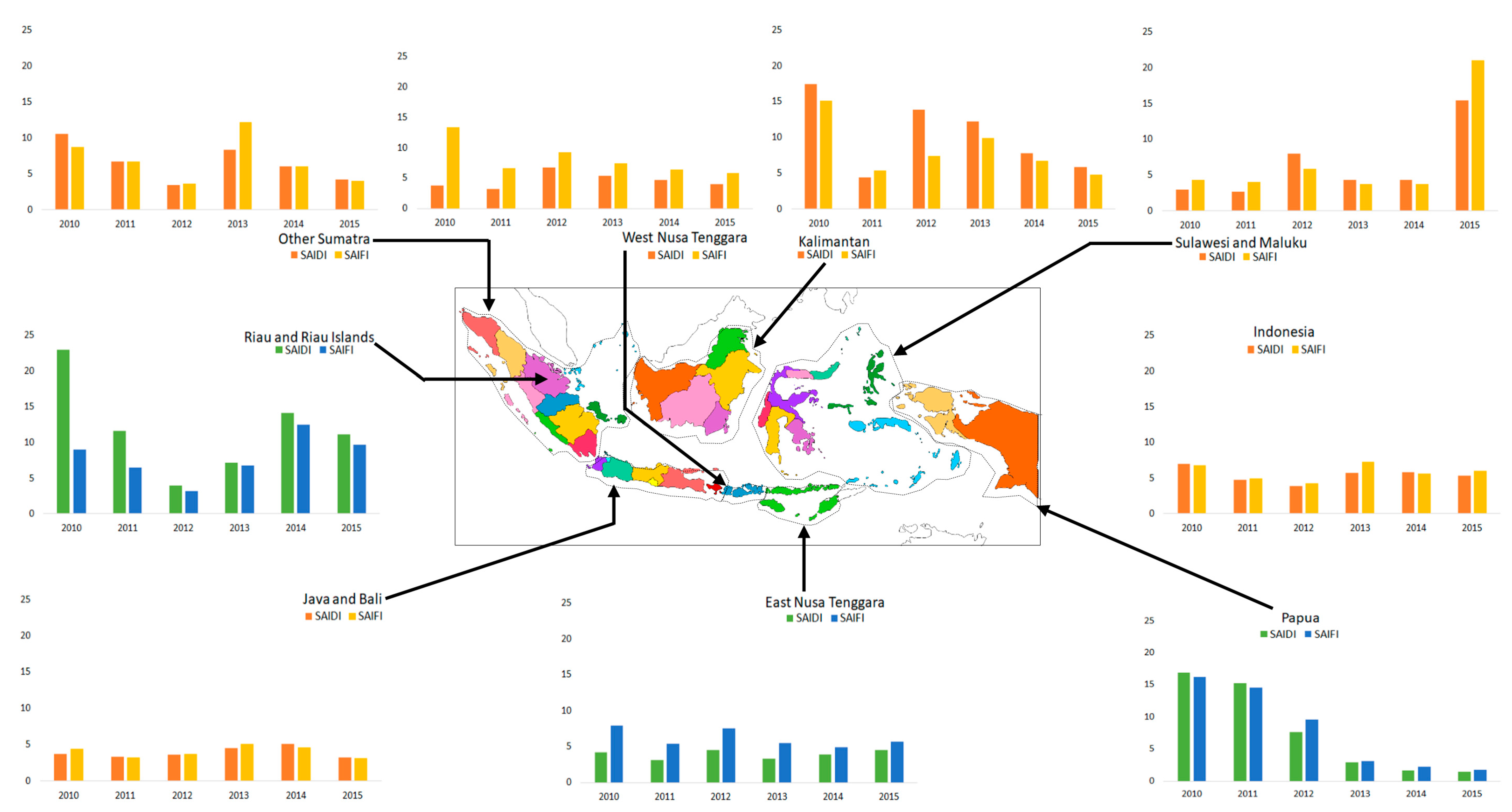
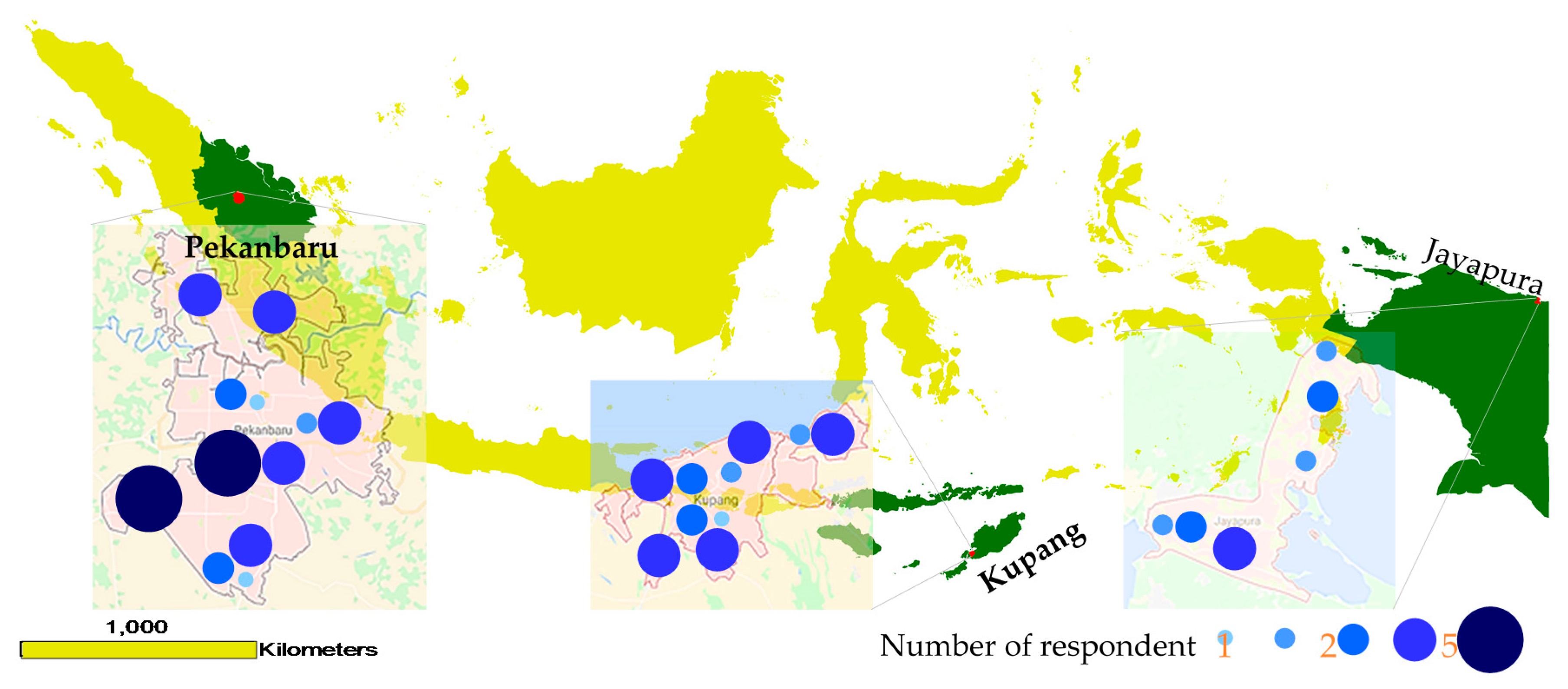
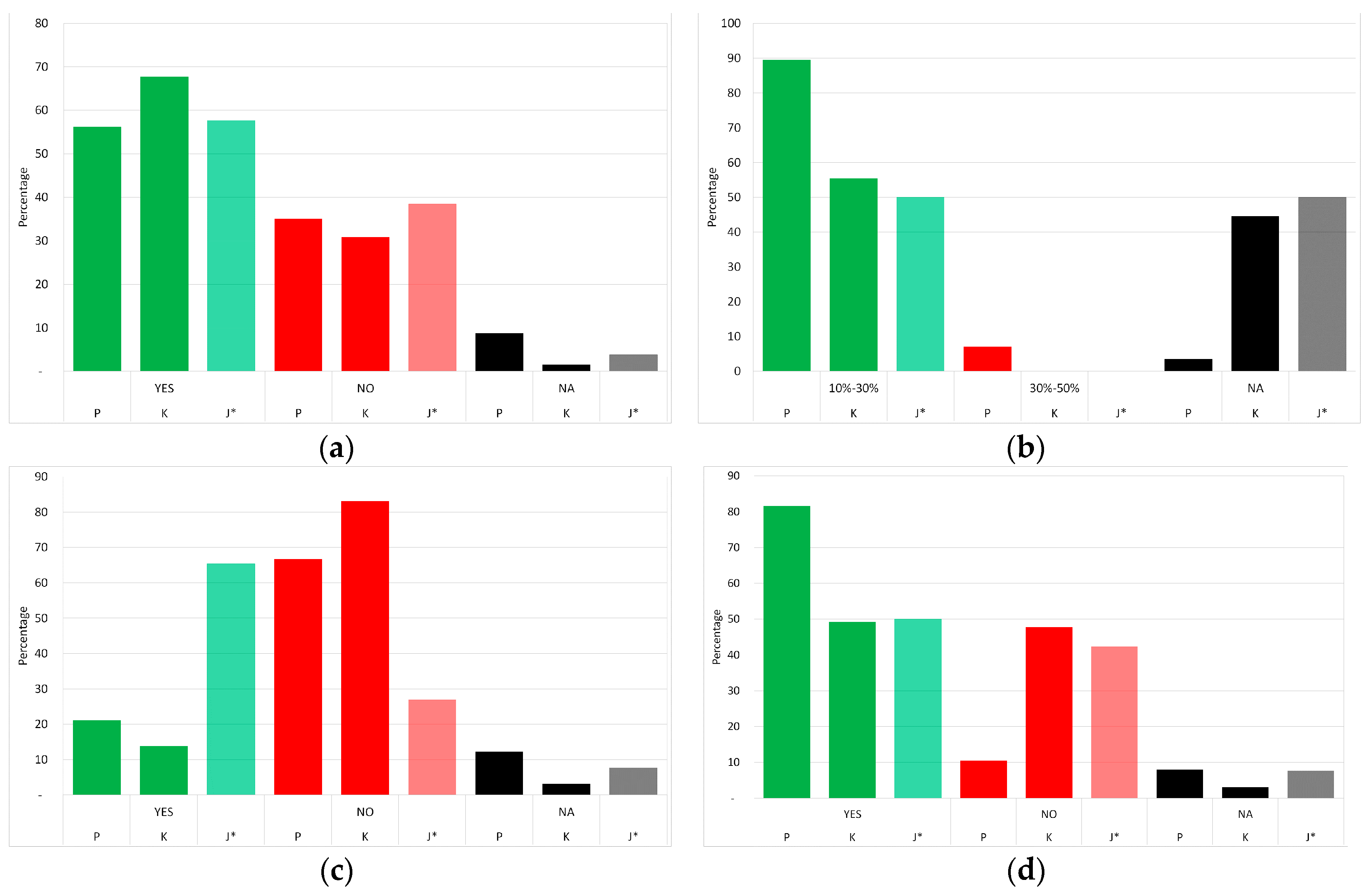

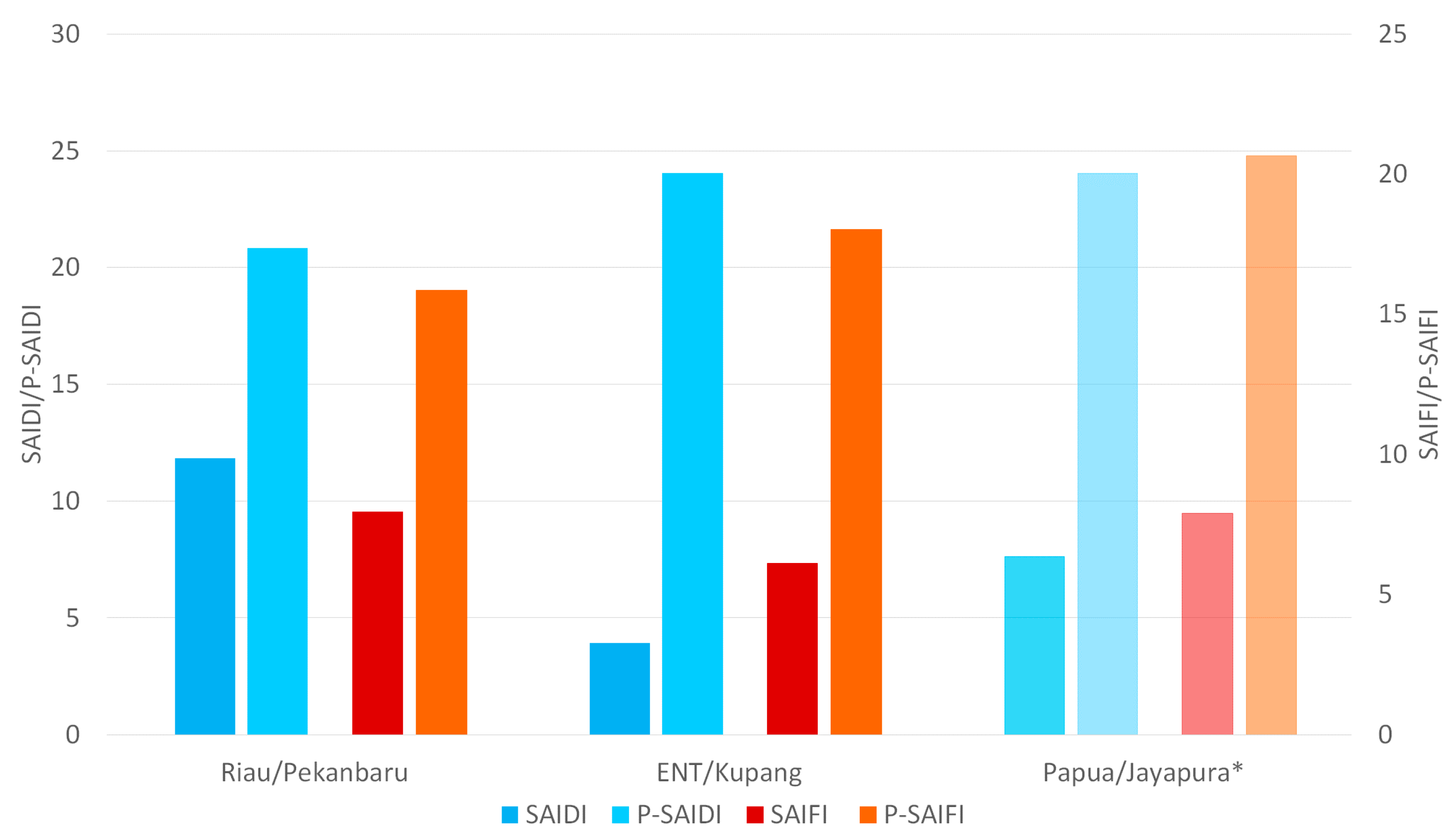
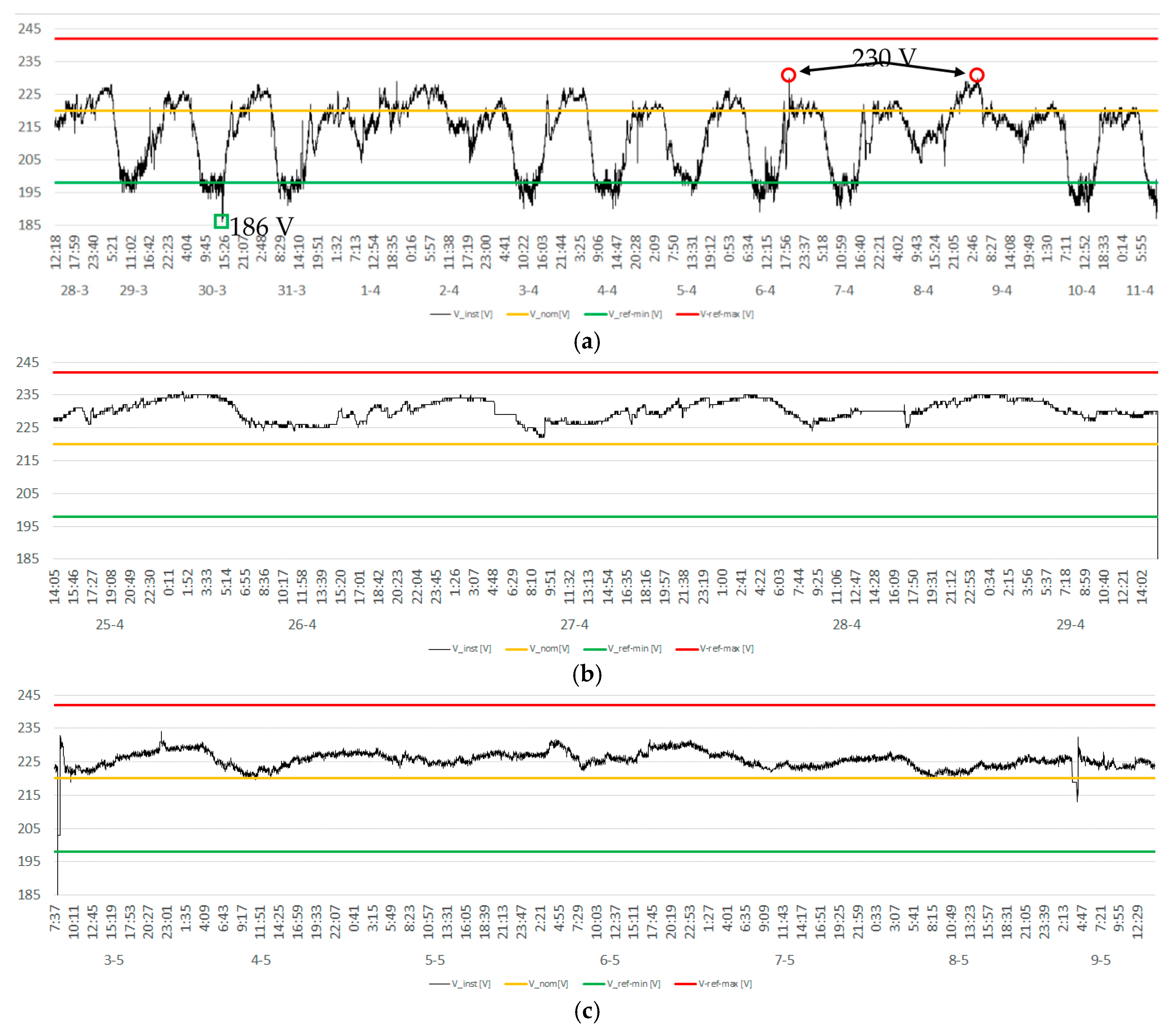


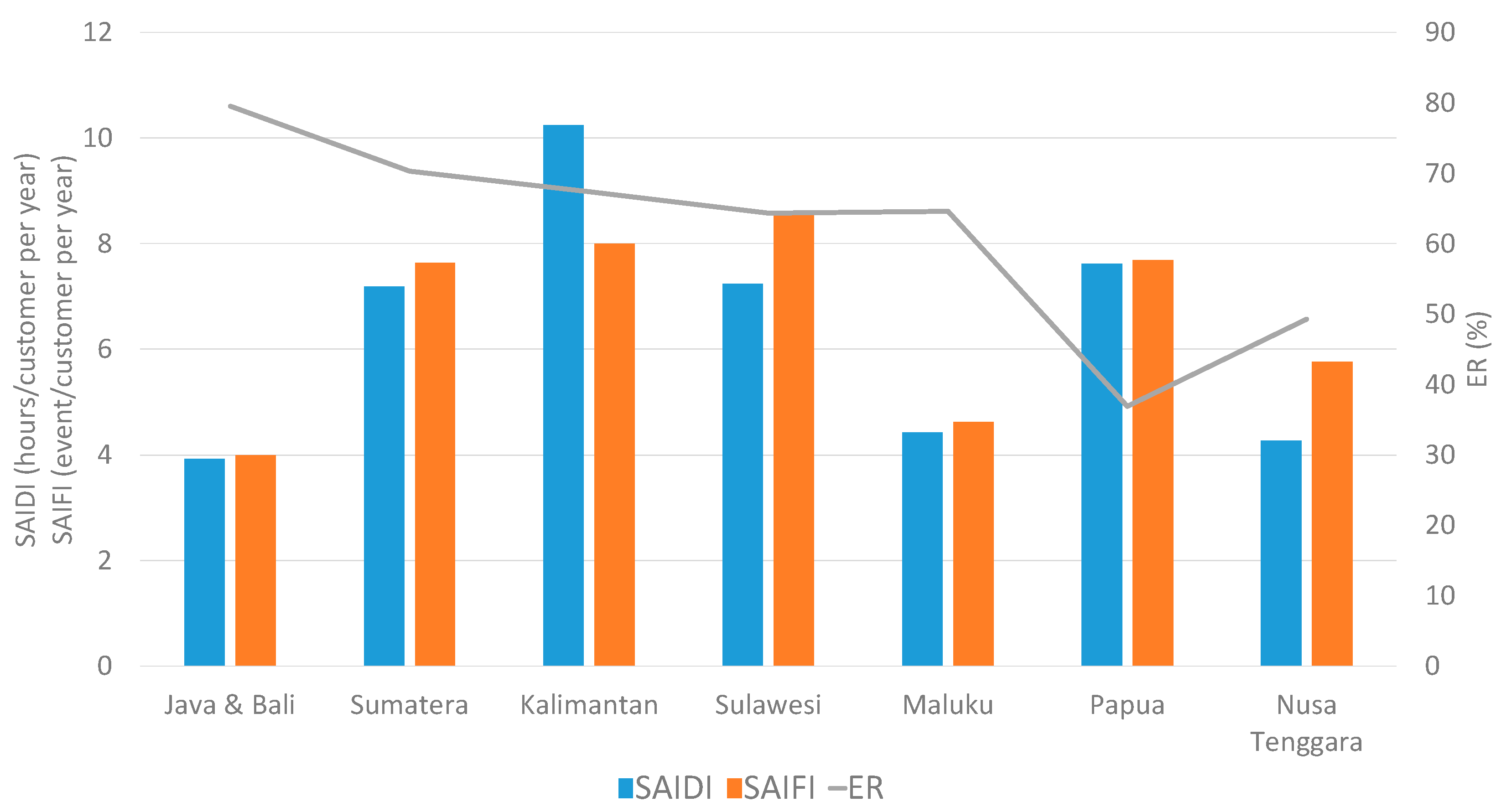
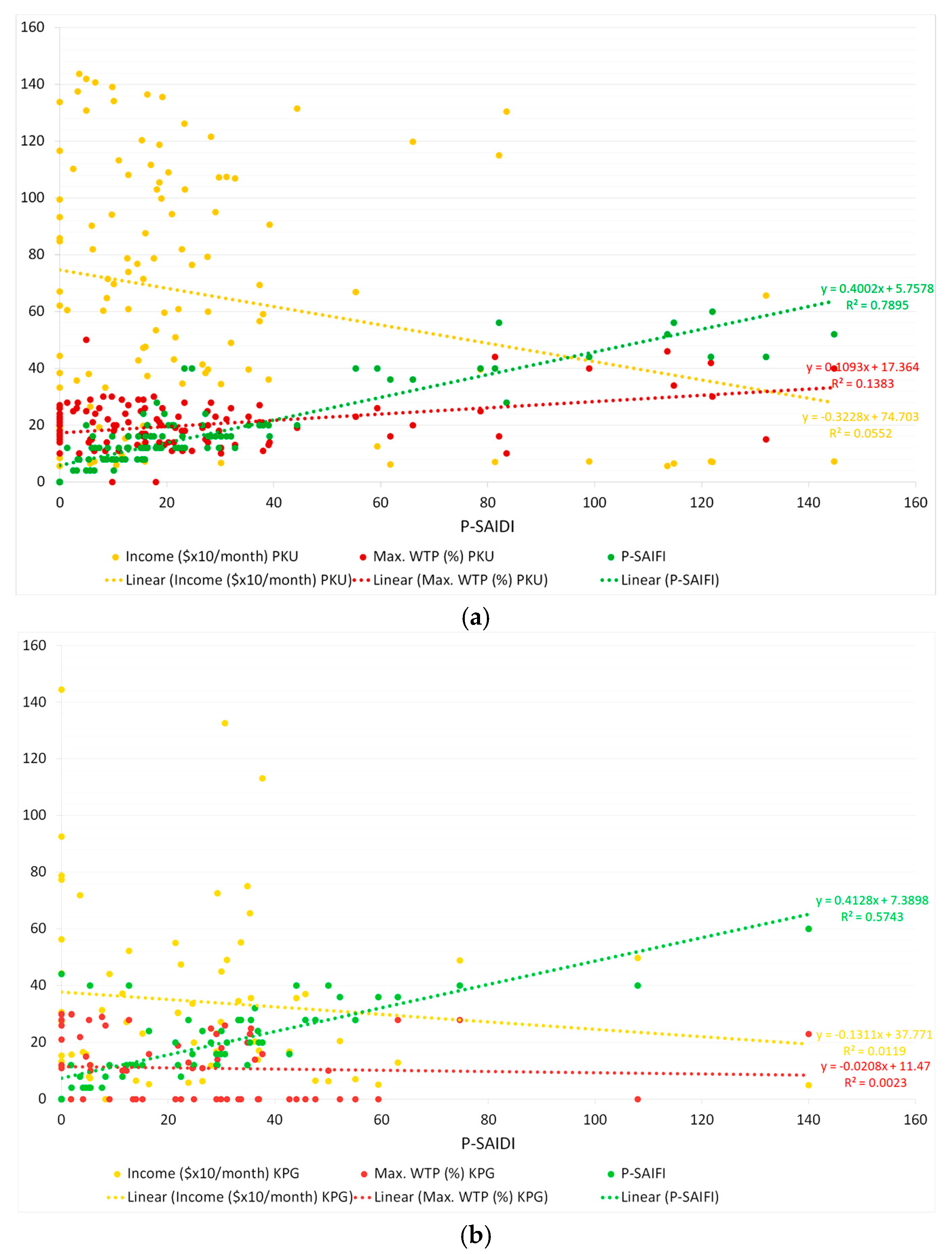
| City | Province | Regional Location in Indonesia | Electrification Ratios of the City’s Provinces in 2015 * | Assumption About the Level of DN Reliability | Period of the Field Survey |
|---|---|---|---|---|---|
| Pekanbaru | Riau | West | 71 | Best | 27/03–14/04 |
| Kupang | ENT | Central | 52 | Moderate | 24/04–29/04 |
| Jayapura | Papua | East | 36 | Worst | 02/05–09/05 |
| Regional Area | 2010 | 2011 | 2012 | 2013 | 2014 | 2015 | Average 2010–2015 | |||||||
|---|---|---|---|---|---|---|---|---|---|---|---|---|---|---|
| SAIDI | SAIFI | SAIDI | SAIFI | SAIDI | SAIFI | SAIDI | SAIFI | SAIDI | SAIFI | SAIDI | SAIFI | SAIDI | SAIFI | |
| Riau & Riau Islands | 22.9 | 9.0 | 11.6 | 6.5 | 3.9 | 3.2 | 7.2 | 6.7 | 14.1 | 12.5 | 11.1 | 9.6 | 11.8 | 7.9 |
| Papua | 16.8 | 16.1 | 15.2 | 14.5 | 7.6 | 9.5 | 3.0 | 3.1 | 1.7 | 2.3 | 1.4 | 1.8 | 7.6 | 7.9 |
| ENT | 4.2 | 7.8 | 3.1 | 5.3 | 4.5 | 7.5 | 3.3 | 5.5 | 3.9 | 4.9 | 4.5 | 5.6 | 3.9 | 6.1 |
| Indonesia | 7.0 | 6.8 | 4.7 | 4.9 | 3.85 | 4.22 | 5.76 | 7.26 | 5.81 | 5.58 | 5.31 | 5.97 | 5.4 | 5.8 |
| Parameter | Unit | P | K | J * | ||||||
|---|---|---|---|---|---|---|---|---|---|---|
| SAIDI | hours/customer per year | 7.9 | 6.1 | 7.9 | ||||||
| SAIFI | number of interruption/customer per year | 11.8 | 3.9 | 7.6 | ||||||
| P-SAIDI | hours/customer per year | 21 | ± | 33 | 24 | ± | 33 | 24 | ± | 39 |
| P-SAIFI | number of interruption/customer per year | 16 | ± | 3 | 18 | ± | 3 | 21 | ± | 3 |
© 2018 by the authors. Licensee MDPI, Basel, Switzerland. This article is an open access article distributed under the terms and conditions of the Creative Commons Attribution (CC BY) license (http://creativecommons.org/licenses/by/4.0/).
Share and Cite
Kunaifi; Reinders, A. Perceived and Reported Reliability of the Electricity Supply at Three Urban Locations in Indonesia. Energies 2018, 11, 140. https://doi.org/10.3390/en11010140
Kunaifi, Reinders A. Perceived and Reported Reliability of the Electricity Supply at Three Urban Locations in Indonesia. Energies. 2018; 11(1):140. https://doi.org/10.3390/en11010140
Chicago/Turabian StyleKunaifi, and Angèle Reinders. 2018. "Perceived and Reported Reliability of the Electricity Supply at Three Urban Locations in Indonesia" Energies 11, no. 1: 140. https://doi.org/10.3390/en11010140





